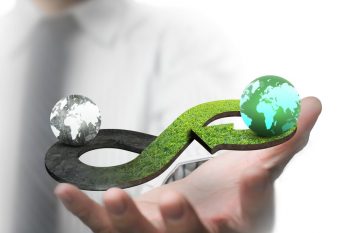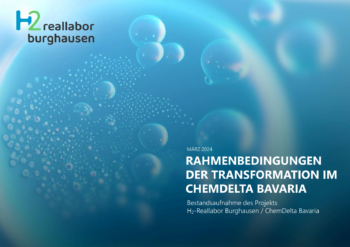Series of articles Carbon Management: What are possible ways to use CO2?
With the European climate neutrality targets for 2050 firmly in place, carbon management is moving into the focus of sustainable environmental practices. The challenge is not only to reduce emissions, but also to effectively manage unavoidable emissions. This requires the use of carbon capture technologies that enable either underground storage (Carbon Capture and Storage – CCS) or integration into a closed carbon cycle (Carbon Capture and Utilization – CCU). This series of articles provides an overview of carbon capture technologies, possible utilization of CO2, storage methods, transportation options and political efforts in the context of carbon management.
Contents of the article series
What are possible ways to use CO2?
The term CCU stands for Carbon Capture and Utilization, i.e. CO2 capture and subsequent further processing or use. There are two ways to utilize CO2:
- The direct use of CO2 (without chemical conversion)
- Material use for the production of synthetic raw materials (with chemical conversion)
The direct use of CO2 is already established, while the material use for the production of synthetic raw materials represents a possible building block on the way to climate neutrality, particularly in the chemical industry.
Utilization without chemical conversion
CO2 is mainly used directly in the food and beverage industry, for example for the subsequent production of carbonated beverages, for conveying beverages at dispensing systems, for shock freezing food and as a protective gas to extend the shelf life of food. [1] Use in the food/beverage industry accounts for around half of today’s demand for CO2, is characterized by very high purity and traceability requirements [2] and is therefore only supplied in batches by trailer (truck).
Use as a chemical feedstock
The larger prospective area of application is the use of CO2 as a raw material, primarily in the chemical industry for conversion into new products. Current applications of CO2 under chemical conversion already include the synthesis of urea from ammonia for the production of fertilizers and AdBlue, as well as the precipitation of milk of lime into precipitated calcium carbonate, an additive in the paper industry, and color pigment. In both applications, however, no external CO2 is fed in, but is captured from previous process steps and used (see Figure 1).

In the future, CO2 can also be used as a raw material in basic chemistry to replace existing fossil, carbon-based raw materials. A distinction is made between two CO2-based processes for the production of so-called olefins (e.g. ethylene, propylene, butene/butadiene) and aromatics (e.g. benzene, toluene, xylene). The products are summarized as High Value Chemicals (HVC). [3] [4]
In the Fischer-Tropsch process, synthetic naphtha is produced from CO2 and hydrogen (synthesis gas). This can replace the fossil naphtha currently obtained from crude oil. Further processing then takes place in crackers to obtain the desired HVC mixture.
The so-called MtO/MtA routes are based on the synthesis of CO2 and hydrogen to methanol. With appropriate catalysts and reaction conditions, various olefins (methanol-to-olefins, MtO) or aromatics (methanol-to-aromatics, MtA) can then be synthesized from methanol.

These HVCs are then used at the start of the chemical value chain, for example in plastics production.
In addition to the production of HVCs for basic chemicals, synthetic fuels (SynFuels, E-Fuels) can also be produced using CO2. Methanol, for example, can also be used directly as a fuel. Fischer-Tropsch synthesis can also be used to produce various fuels that are similar to petroleum-based fuels and can replace them, such as Fischer-Tropsch kerosene for aviation. Methanation for the production of methane from hydrogen and carbon dioxide is another way of using this synthetically produced methane to replace conventional natural gas, e.g. in road or shipping traffic. The synthetically produced methane is roughly equivalent to natural gas and can be used both in road transport and in liquid form as a fuel in shipping. As a sustainable fuel for aviation, synthetic kerosene can be produced from Fischer-Tropsch synthesis, for example.
It should be noted that the production of green hydrogen as a necessary educt leads to an additional demand for renewable electricity generation. In addition, both synthetic fuels and plastics are usually incinerated at the end of their useful life. The previously bound CO2 then escapes back into the atmosphere. In terms of a closed-loop economy, CO2 capture at waste incineration plants is therefore necessary for plastics. The emissions from synthetic fuels must be removed from the atmosphere by other means, for example via DAC or BECCS.
There is still no clear transformation path for the chemical industry. The use of CO2 (CCU) is only one of several options for the transition away from fossil carbon sources. In addition to CCU, increased mechanical and chemical recycling and the increased material use of biomass are the most promising options. The extent to which these three options for carbon supply will become established depends largely on the costs when the process routes are ready for the market and the regulatory framework (e.g. for balancing CCU products or the sustainability requirements for biomass).
- More Information
Literatur
[1] Pleier A., Kracht H., Guminski A.: Analyse CO2-Infrastrukturbedarf in Bayern – Eine vbw Studie, erstellt von der FfE – Forschungsgesellschaft für Energiewirtschaft mbH. München: FfE GmbH, 2023.
[2] MINIMUM SPECIFICATIONS FOR FOOD GAS APPLICATIONS (MINIMUM SPECIFICATIONS FOR FOOD GAS APPLICATIONS). Ausgefertigt am 2020-01-01; Brüssel, Belgien: EIGA, 2020.
[3] Roadmap Chemie 2050 – Auf dem Weg zu einer treibhausgasneutralen chemischen Industrie in Deutschland. München, Frankfurt: Dechema, 2019.
[4] Chemistry4Climate – Wie die Transformation der Chemie gelingen kann. Frankfurt am Main, Düsseldorf: Verband der Chemischen Industrie e. V. (VCI), 2023.

